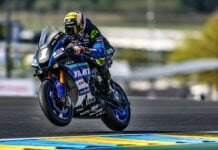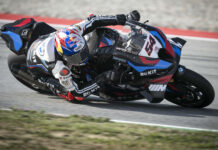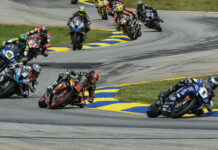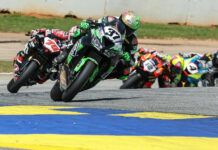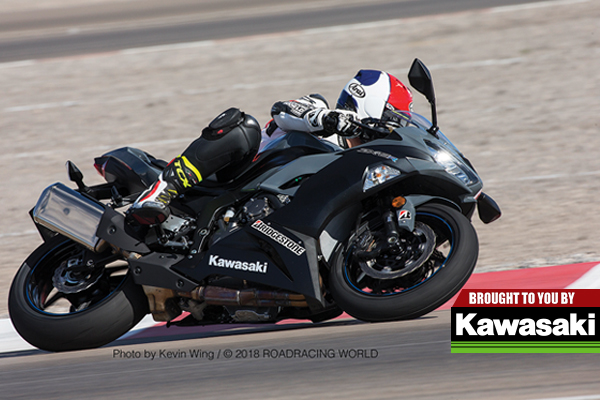To read more articles like this one originally published in the December 2018 print issue of Roadracing World, subscribe to Roadracing World.
This feature article is brought you by Kawasaki Motors Corp., USA.
Kawasaki Motors Corp., U.S.A. (KMC) markets and distributes Kawasaki motorcycles, ATVs, side x sides, and Jet Ski® watercraft through a network of almost 1,100 independent retailers, with close to an additional 7,400 retailers specializing in general purpose engines. KMC and its affiliates employ nearly 3,100 people in the United States, with approximately 260 of them located at KMC’s Foothill Ranch, California headquarters.
Kawasaki’s tagline, “Let the good times roll.®”, is recognized worldwide. The Kawasaki brand is synonymous with powerful, stylish and category-leading vehicles. Information about Kawasaki’s complete line of powersports products and Kawasaki affiliates can be found on the Internet at www.kawasaki.com.
Copyright 2018-2019, Roadracing World Publishing, Inc.
Return Of The $10,000 600cc Sportbike
By Chris Ulrich
Few things have changed since the last time Kawasaki introduced a new ZX-6R. The motorcycle sales environment is still tough. Road racing is still working to recover. Kawasaki doesn’t have any official entry in top-level road racing in the United States. And some media outlets are still making stuff up.
We’ve all read the headlines about the demise of the 600cc inline four-cylinder. The tales were so convincing that they fooled the powers that be at Dorna and MotoAmerica into looking at an alternate class featuring Middleweight Twins instead of Inline Fours. But the stories were Fake News and manufacturers keep building and selling fully-faired middleweight category sportbikes. Honda, the biggest target of the fiction, recently announced the return of the CBR600RR as a 2019 model. Suzuki also continues to build and sell the shared-platform GSX-R600 and GSX-R750 models, and Yamaha introduced an upgraded YZF-R6 in early 2017. And now I’m writing about an upgraded 2019 model Kawasaki ZX-6R. All indicators show the middleweight supersport category is still alive and still relevant. In fact, it makes up roughly 25 percent of the fully-faired sportbike market.
There is no denying that the sportbike segment of the industry has some challenges, but people are still buying and riding sportbikes and there is still a place for middleweight three and four-cylinder sportbikes in the market. That place is right between the entry-level sportbike class and the 1000cc sportbike category. The safest and most responsible way to progress in riding is by matching the rider’s skill level with the appropriate displacement. The industry needs models that new riders can graduate to from the 300cc-500cc category. And the argument about 1000cc bikes having enough electronics that anyone can ride them may be great for marketing, but is not the right approach to keep riders in the sport for the long haul. Advanced electronics do a great job at adding a safety net when turned all the way up, but the forces generated by the larger displacement 1000cc engines will always be greater, the power output higher, and the centripetal forces created by a heavier crankshaft, a large stater, and larger pistons will always make larger-displacement motorcycles harder to stop and turn than smaller-displacement motorcycles. And the greater torque and horsepower will always require more physical effort to control on corner exit, no matter how much somebody turns up the traction control—at least if you want the bike to actually move forward and behave in a natural way. It’s physics, plain and simple.

Fully-adjustable front and rear Showa suspension — including new Separate Fork Function-Big Piston (SFF-BP) front forks–allowed Racing Editor Chris Ulrich to tweak the set-up and thus continually improve the 2019 Kawasaki ZX-6R’s racetrack performance at Las Vegas Motor Speedway. – Photo by Kevin Wing, courtesy of Kawasaki.
But in recent years, the typical price of 600cc sportbikes has crept up closer and closer to base-model 1000cc motorcycles, and that seems to have changed consumer behavior. A 600 seemed too expensive for the entry-level rider, so they went for the 400. Then they gravitated to a 1000 when looking to upgrade from a 400 because it seemed like a better dollar-to-performance value than a 600. People often underestimate the massive jump in performance between a 400cc and a 1000cc sportbike.
Kawasaki has decided to do something to bridge the gap and try to change consumer behavior by offering the 2019 non-ABS-model ZX-6R for $9,999, and selling the ABS models for between $10,999 and $11,299. For comparison, the base model ZX-6R is priced $1,399 below the 2019 Suzuki GSX-R600, which has the next-lowest-price in the category. It is also priced $1,799 below the Honda CBR600RR, and $2,199 below the segment’s sales leader, the Yamaha YZF-R6. At 636cc, the ZX-6R also competes with Suzuki’s GSX-R750, which sells for $2,499 more than the base model ZX-6R. You see a pattern here? Kawasaki’s pricing is aggressive. There is no doubt Kawasaki’s margin on the ZX-6R is lower, but the company is not passing the pain on to dealers—the dealer cost-to-MSRP spread for the 2019 model is close to what it was in previous model years. Kawasaki plans to make up for reduced margins by increasing the volume of units sold. That approach could be pure genius or a massive bust, and it will take some time to see how it really plays out in the marketplace and on Kawasaki’s balance sheets.
That lower base price doesn’t mean Kawasaki is shorting its racing contingency programs. Team Green will offer over $500,000 in contingency support for the 2019 ZX-6R in 13 series across the United States, including MotoAmerica, where the ZX-6R is eligible to run the Supersport class with no additional restrictions beyond the general technical rules.
Kawasaki’s new approach for the 2019 ZX-6R follows the industry trend of delaying new model redesigns in an effort to amortize the design and manufacturing costs. So now, instead of ground-up redesigns, we get upgrades that add performance and value, meant to keep consumers engaged without bankrupting the OEM. For 2019, Kawasaki added a quickshifter (KQS) system, changed the gearing, revised the engine mapping to meet Euro 4 emission standards, changed the ergonomics, added LED lighting, and updated the bodywork design. All are smart changes that improve sales appeal and keep the ZX-6R relevant.
Starting with the powerplant, the 2019 ZX-6R retains the same DOHC, 16-valve, liquid-cooled 636cc inline four-cylinder engine featuring a 67.0 mm x 45.1 mm bore and stroke and 12.9:1 compression ratio. Changes to engine mapping allow the ZX-6R to meet Euro 4 emissions standards without adding ride-by-wire throttle control or losing engine performance compared to the 2013 non-Euro 4 specification model. Kawasaki engineers aimed to improve the mid-range performance of the ZX-6R by changing the final drive gear ratio from 16/43 (2.688:1) to 15/43 (2.866:1). The primary and internal transmission gear ratios were unchanged. The 2019 retains the cable-operated F.C.C. slip-assist back-torque-limiting clutch.

Photo by Kevin Wing, courtesy of Kawasaki.
The electronics suite is also mostly unchanged for 2019. Four Kawasaki TRaction Control (KTRC) levels (1-3, plus off) are available on the ZX-6R, along with two power modes. Full Power offers—no kidding—full power while Low Power cuts available output to 80% of maximum horsepower. Between the KTRC and the power modes, the ZX-6R offers eight variations of power control. And while engineers added the previously mentioned Kawasaki Quick Shifter (KQS) unit that allows upshifts without having to close the throttle, there is no auto-blip functionality, so downshifts still have to be made the old-fashioned way, using the clutch.
Kawasaki is offering two-versions of the 2019 ZX-6R with Kawasaki Intelligent Anti-lock Brake System (KIBS). The system uses inputs from wheel speed and brake pressure sensors, plus the ECU, to regulate the amount of brake pressure reduction when slippery conditions are present.
The 2019 ZX-6R chassis remains mostly unchanged, with rake and trail for the twin-spar pressed aluminum frame remaining 23.5 degrees and 102 mm. The two-piece die-cast aluminum sub-frame and rear swingarm are also unchanged. The front suspension consists of 41 mm Showa Separate Fork Function-Big Piston (SFF-BP) front forks. The SFF-BP system separates the fork functions with the pre-load adjustment located only in the left fork leg, while damping adjustments are located only in the right fork leg. Both legs have springs and the fork piston size is 37.2 mm, which should in theory make the fork more sensitive to adjustments. A fully adjustable Showa gas-charged piggyback-reservoir rear shock works through a Kawasaki Uni-Track linkage.
The 2019 model’s wheelbase is slightly longer, changed from 54.9-inches (1,385 mm) to 55.1-inches (1,399 mm), courtesy of the previously mentioned, smaller, 15-tooth countershaft sprocket. The Kawasaki ZX-6R rolls on a set of Bridgestone Hypersport S22 radial tires.
The biggest changes made for 2019 come in ergonomics and bodywork. While the rider triangle—the relative location of the footpegs, handlebars, and seat—is unchanged, the seat length between the tail section to the fuel tank is slightly shorter. Kawasaki engineers also added a new clutch lever with five positions of adjustability. A redesigned upper fairing retains the Ninja’s large center air intake while adding LED headlights and improving wind protection for the rider. The new LED rear taillight was modeled after the unit used on the ZX-10R. Kawasaki will offer the ZX-6R in three colors, Metallic Flat Spark Black (non-ABS), Pearl Strom Gray Metallic Spark Black (Non-ABS, ABS), and the KRT edition.
All the changes add appeal to what was already a solid, well-performing bike in the category. Selling the base model 2019 Kawasaki ZX-6R for $9,999 has the potential to turn the middleweight Supersport category on its head.
***
Kawasaki chose Las Vegas as the background to launch the ZX-6R, first unveiling the new model the morning of the media day during the 2018 American International Motorcycle Expo (AIMExpo), then allowing journalists to ride the bike on the street and racetrack over two days.
The route selected for the street segment took us west out of Las Vegas toward Mount Charleston, climbing 8,000 feet before heading back to the city. The route consisted of highways, twisty mountain roads, slick and wet roads, and some city riding as we headed from and then back to the speedway. Our ride for the day was the $11,299 KRT model with ABS, which makes sense since the ABS function on most road-going motorcycles is designed for use on the street. I could tell the ZX-6R had a good balance of sport and comfort a few miles into the ride. Ergonomics were good during longer stints on the bike; my knees were not too cramped and the bar position allowed me to relax my shoulders and limit fatigue. Wind protection, even at high speed, was more than adequate.
The added torque from the engine having that extra displacement came in handy when accelerating onto the highway or jumping from light to light. Cruising down the highway in top gear, the engine also allows relatively brisk acceleration without having to downshift. And engine vibration reaching the rider also seems to be pretty minimal.

The Kawasaki ZX-6R’s 636cc engine produces more mid-range torque than a typical 600cc-class sportbike, giving a street rider more gear-selection options on twisty roads. Ergonomics, comfort, suspension, and tire performance are also good for road use. – Photo by Kevin Wing, courtesy of Kawasaki.
Twisty-road performance was good; the 636cc engine gives plenty of gear selection options, and the quick-shifter (up only) worked as expected. A negative I noticed while on the street ride was the engine temperature while going from stoplight to stoplight. Ambient temperatures were in the 80s and the bike was running up around 225-230 degrees Fahrenheit while sitting in traffic.
The ZX-6R has a stable chassis that worked well on the highway and through the canyon roads at a good clip, while the Bridgestone Hypersport S22 performed well in all conditions, including slick, cold, wet roads at the top of Mount Charleston. But it would be irresponsible to test the ZX-6R’s limits on public roads, so we headed to the Classic Course at Las Vegas Motor Speedway to find the true high-speed performance potential of the Kawasaki ZX-6R.
It had been about nine years since the last time I turned a wheel around the Classic Course. The racetrack is short, made up of mostly second-gear corners with two straightaways and one fast, fourth-gear right off the back straight. I was able to get my head wrapped back around the track after a few laps. Going from the street to the track, Kawasaki put us on the base model with no ABS. It was a smart choice as we were there to test racetrack performance and most ABS systems are made for safety on the road instead of fast lap times around a racetrack. Bridgestone R11 DOT-labelled racing tires were set at 34 psi in the front and 24 psi in the rear (coming off the tire warmers) for the track sessions.
The first thing I noticed rolling out of pits was the engine. The torquey 636cc engine makes the ZX-6R more user-friendly on the track—especially for larger riders. The rider can rev the engine for absolute maximum performance, or leave the bike in a higher gear than normal and use the mid-range torque to smoothly accelerate out of a corner. The ZX-6R pulls hard until 14,500 rpm, signing off about 1,500 rpm before the claimed 16,000 rpm redline. On deceleration, the F.C.C. back-torque-limiting clutch handled everything I asked it to do, without the rear wheel stepping out during heavy braking.
The handling characteristics and feel are the same as on Kawasaki 600cc models I’ve tested in the past. The bike is stable on the brakes and at the corner apex, but takes more effort to turn in and struggles to finish a turn. The 2019 version of the ZX-6R was no different at the start of the day. Once up to speed I made systematic changes to the set-up to improve steering and increase overall support from the suspension.
My first change was to add two turns of rear spring pre-load (from 6 positions in to 8 positions in) to improve overall steering at the apex and exit of the corner. Next on the agenda was to increase front pre-load (from 6 turns in to 8 turns in) to balance the bike and add braking support. Then I focused on improving front feel by changing the damping settings, and I had a Kawasaki tech add a half turn of rebound (from 4 turns out to 3.5 turns out) to control rate of return, then added half a turn (from 4.5 to 4 turns out) of compression for more support. We continued to tweak on the chassis as the sessions went on and I pushed harder. The next step was adding a 2 mm shim under the shock clevis. From there we added more front pre-load, settling on 12 turns in, until there was adequate support on the brakes without ruining the chassis balance. The middleweight Kawasaki responded well to raising the entire bike.

The ZX-6R liked more spring preload at both ends as well as inserting a shim under the shock clevis. – Photo by Kevin Wing, courtesy of Kawasaki.
A big part of my comfort came from understanding the Showa SFF-BP forks. They work better than standard Showa BPF forks through the entire range of travel and have more feel at the bottom of the stroke at the apex. The adjustment range is also precise. At the rear, the ZX-6R has decent edge grip along with plenty of feel when the rear tire starts to spin. I was very comfortable allowing the rear to spin once I had the bike stood up and pointed on corner exit. And as the laps piled up and I got even more comfortable, I was able to eventually turn a 1:21 lap around Las Vegas. That’s a solid lap time for a standard, stock motorcycle and it shows the high performance potential of the ZX-6R. Performance potential that comes with a $9,999 MSRP.
There’s nothing not to like about that!

The specification chart for the 2019 Kawasaki ZX-6R. Copyright 2018-2019, Roadracing World Publishing, Inc.


